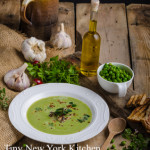We all know that chickpeas are a fiber-filled addition to soups and salads, but have you ever thought about the ingredient that you’re leaving behind in a can of chickpeas? That thick, cloudy liquid that typically gets poured down the drain when chickpeas are drained. That liquid id called aquafaba, and it might just be the ingredient your baked goods and cocktails are missing.
Aquafaba is the liquid that’s leftover when dry chickpeas are cooked, and it is the brine that canned chickpeas soak in to maintain freshness while sitting on grocery store shelves. You should save it because it’s an excellent vegan egg substitute that can be used in baked goods, to emulsify vegan mayonnaise to add a foamy element to your favorite cocktails, and so much more.
To use aquafaba shake it in a cocktail shaker for an extra frothy espresso martini or whisk it alongside a thin stream of olive oil for a vegan aioli. Although the liquid from other beans (like black beans and kidney beans) could work just as well, chickpeas don’t give off any color, so the resulting clear, yet slightly cloudy, liquid is much more versatile. Another nice thing about aquafaba is that you don’t need to use too much of it. Generally, three tablespoons of aquafaba will replace one egg.
Aquafaba has a mild buttery and bean like flavor, but it easily takes on the flavor of what it’s added to and tends to cling to other flavors quite well, which explains why it works well in mayonnaise and in cocktails. Aquafaba should be stored in an airtight container in the refrigerator for up to 3 days.
Aside from the benefit of replacing an animal-based product with a plant based product, aquafaba doesn’t have a lot of nutrients, and it certainly has less protein than an egg does. It’s low in calories and carbohydrates, but it’s also pretty low in vitamins and minerals. If you aren’t vegan then there aren’t a lot of health benefits to using aquafaba over regular eggs. It is a good step in preventing food waste, though.
©Tiny New York Kitchen © 2020 All Rights Reserved
One easy tip for making sure fresh fruit and vegetables don’t go to waste is to wash, dry and prep them immediately so they are ready for snacking and cooking right from the fridge.
“Work With What You Got!”
©Tiny New York Kitchen © 2020 All Rights Reserved
I grew up in the Midwest where it was considered a mortal sin to waste food. The motto was “waste nothing and make the most of every ingredient.” Here are some ways for you and your family to make the most of ingredients that otherwise may make their way into the trash bin.
Stewed Fruit does double duty as a topping for pancakes, waffles and ice cream while giving you a serving of fruit. Get started with apples and dried fruits.
Super Stems. Don’t waste the nutrients in stems of greens like collards and kale, or vegetables like broccoli and cauliflower. Use them in longer cooking soups and stews.
Save The Soft. Baked desserts are a great way to use up slightly overripe fruit.
Use It, Don’t Lose It. When you by a special ingredient for a recipe, don’t waste what’s left. Get creative and add them to some of your favorite recipes.
Make Soup with leftovers. Vegetables, grains, and meats make wonderful soups. If you don’t have time to make soup right away, freeze the leftovers until you have a good cooking day. Don’t forget to label and date what you’re freezing for later.
“Work With What You Got!”
© Victoria Hart Glavin Tiny New York Kitchen © 2017 All Rights Reserved








